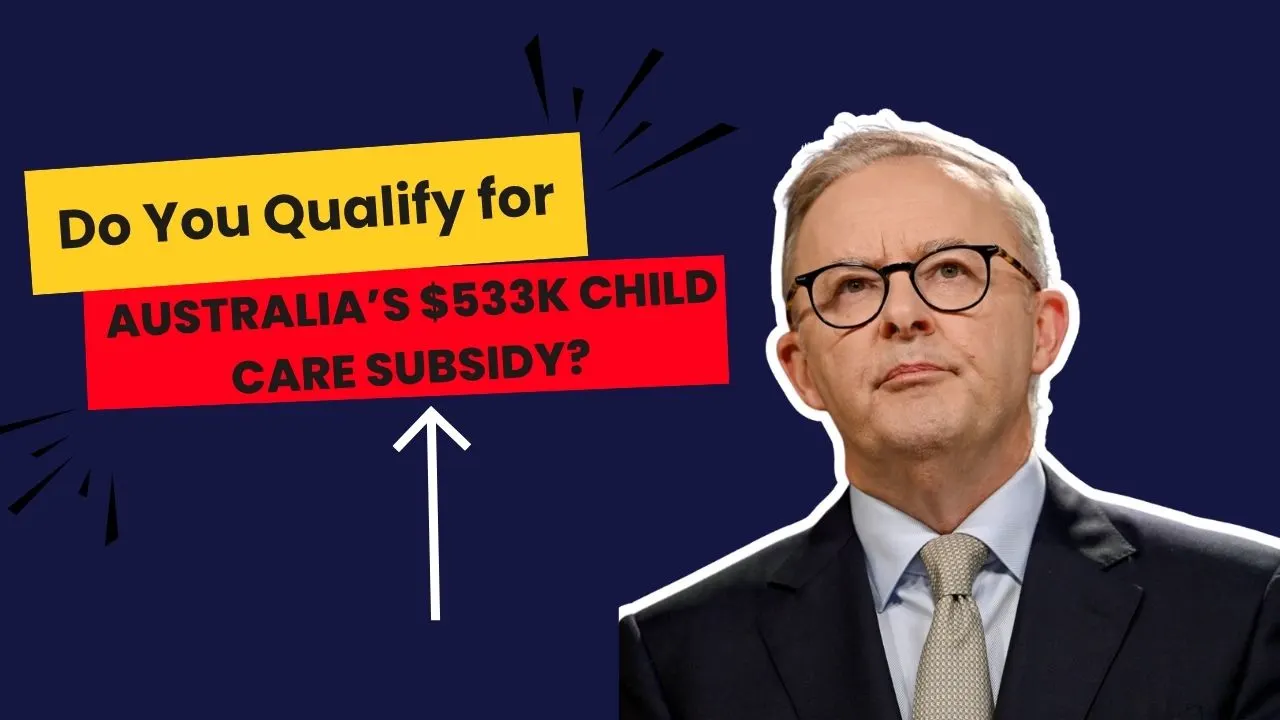For American families considering relocation to Australia or those already living there as expatriates, understanding the Australian government’s child care support system is crucial, especially with the introduction of the $533,290 Child Care Subsidy reform set to take effect in January 2026. This initiative, often referred to as the “$533K Child Care Subsidy” due to its income eligibility cap of AUD $533,280, aims to make early childhood education and care (ECEC) more accessible by offering up to 90% subsidies for eligible families. This article, tailored for a U.S. audience, explains the subsidy’s details, eligibility criteria for Americans living in Australia, application processes, and alternative support options, helping you determine if you qualify.
Understanding Australia’s Child Care Subsidy
The Child Care Subsidy (CCS) is Australia’s primary financial assistance program for families using approved child care services, such as daycares, preschools, or after-school programs. Administered by Services Australia through the Centrelink system, the CCS reduces out-of-pocket child care costs by paying subsidies directly to providers, who then lower fees for families. The $533,290 reform, effective January 2026, introduces significant changes, including the “Three-Day Guarantee,” which ensures at least 72 hours of subsidized care per fortnight (approximately three days per week) for every eligible child, regardless of parental employment or activity levels.
For U.S. families, this reform is particularly relevant if you’re planning to move to Australia for work, study, or family reasons, as it offers substantial financial relief for child care expenses, which can be a significant burden. Unlike U.S. programs like the Child and Dependent Care Credit, which provides tax relief up to $3,000-$6,000 annually, the Australian CCS directly reduces fees, making it more immediate and impactful for families with young children.
Key Features of the $533K Child Care Subsidy
The $533,290 figure refers to the maximum combined family income eligible for the subsidy, covering a broad range of households, from low to upper-middle-income earners. Key aspects include:
-
Three-Day Guarantee: Starting January 2026, all eligible families receive at least 72 hours of subsidized care per fortnight, removing the previous activity test that required parents to work, study, or volunteer to qualify. This ensures access for children even if parents are temporarily unemployed or transitioning between jobs.
-
Income-Based Subsidies: Families earning up to AUD $83,280 receive a 90% subsidy on child care fees, with the rate gradually decreasing to 0% for incomes approaching AUD $533,280. For example, a family earning AUD $200,000 might receive a 50% subsidy, significantly lowering costs.
-
Higher Subsidy for Multiple Children: Families with more than one child aged 5 or under may receive a higher subsidy for the second and subsequent children, calculated separately from the eldest child’s standard rate. This does not apply to In-Home Care (IHC), which is subsidized per family.
-
Additional Child Care Subsidy (ACCS): For families facing hardships, such as financial crises or domestic violence, the ACCS can cover up to 100% of child care costs, ensuring vulnerable children access safe environments.
These features make the CCS a flexible and inclusive program, contrasting with U.S. systems where support is often limited to tax credits or state-specific programs like Head Start, which have stricter eligibility criteria.
Eligibility Criteria for U.S. Residents
For American families living in Australia, eligibility for the CCS hinges on meeting specific requirements, particularly residency rules. Here’s what you need to know:
-
Residency Requirements: You and your child must be Australian residents or hold an eligible visa, such as a Temporary Skill Shortage (TSS) visa (subclass 482), Partner visa (subclass 820/801), or Permanent Resident visa. U.S. citizens on temporary visitor visas or student visas may not qualify unless they meet specific exemptions. Check Services Australia’s residency rules for details.
-
Child Eligibility: The child must be 13 or younger, not attending secondary school (unless exempted, e.g., for children with disabilities), and enrolled in an approved child care provider under Australia’s national framework. All children must meet immunization requirements, similar to U.S. mandates for public schools.
-
Parental Responsibility: You must be the parent or legal guardian responsible for paying child care fees. This aligns with U.S. tax credit rules, where the claimant must be the primary caregiver.
-
Income Threshold: Your combined family income must be below AUD $533,280 annually. For context, this is roughly USD $350,000 (based on a June 2025 exchange rate of AUD 1 = USD 0.66), making the subsidy accessible to many expatriate families.
-
No Activity Test (Post-January 2026): Unlike the current system, which requires parents to engage in recognized activities (e.g., work, study, or volunteering), the 2026 reform eliminates this barrier, benefiting families in transition, such as those relocating from the U.S.
Special provisions exist for Aboriginal and Torres Strait Islander children, who qualify for at least 36 hours of subsidized care per fortnight regardless of parental activity, provided families voluntarily report this status to Services Australia.
Application Process for Americans
Applying for the CCS is straightforward but requires a myGov account linked to Centrelink, Australia’s equivalent to the U.S. Social Security Administration for benefit distribution. Here’s how U.S. residents can apply:
-
Create a myGov Account: Visit my.gov.au to set up an account, similar to creating an IRS online account for tax purposes. You’ll need to provide identification, such as a passport or visa details.
-
Submit Income and Enrollment Details: Upload income statements (e.g., U.S. tax returns or Australian pay stubs) and child care enrollment details through myGov. Update your income estimate annually to avoid incorrect subsidy amounts or potential debts.
-
Provider Confirmation: Your child care provider must be approved by the Australian Department of Education. They will confirm enrollment with Centrelink, ensuring subsidies are applied directly to fees.
-
Monitor Payments: Subsidies are paid to providers, reducing your fees upfront. Check your myGov account for payment confirmations, similar to tracking U.S. tax refunds on IRS.gov.
For families eligible for the ACCS, additional documentation (e.g., proof of hardship) may be required, similar to applying for U.S. programs like LIHEAP. Contact Services Australia’s Centrelink families line (136 150) for assistance.
Comparing to U.S. Child Care Support
For Americans, the CCS offers more direct relief than U.S. equivalents. The U.S. Child and Dependent Care Credit provides up to $3,000-$6,000 in tax relief for work-related child care expenses, but it’s claimed annually and benefits higher earners disproportionately. State programs like California’s CalWORKs or Head Start target low-income families but have limited spots and strict criteria. In contrast, the CCS’s direct fee reduction and broader income eligibility (up to USD $350,000 equivalent) make it more accessible for expatriates. However, U.S. programs like SNAP or LIHEAP can complement child care support for low-income families, offering food and utility assistance.
Challenges for U.S. Families
American expatriates may face hurdles:
-
Visa Restrictions: Temporary visa holders may not meet residency rules, limiting access. Consult Services Australia to confirm eligibility.
-
Income Documentation: Converting U.S. income to AUD and providing accurate estimates can be complex, especially for self-employed expats.
-
Provider Availability: Approved providers may have waitlists in urban areas like Sydney or Melbourne, similar to competitive U.S. daycare markets.
-
Misinformation: Be cautious of unofficial sources claiming exaggerated benefits, like the “$533K subsidy” implying a direct payment, which is actually the income cap. Verify details on Services Australia or my.gov.au.
Alternative Support Options
If you don’t qualify for the CCS, explore:
-
Additional Child Care Subsidy (ACCS): Covers up to 100% of fees for families in crisis, similar to U.S. emergency assistance programs.
-
State-Based Support: Some Australian states, like New South Wales, offer additional ECEC subsidies or fee relief. Check nsw.gov.au for details.
-
U.S. Benefits: If you maintain U.S. tax obligations, claim the Child and Dependent Care Credit or explore state programs upon return.
FAQs
1. Can U.S. citizens living in Australia qualify for the CCS?
Yes, if you hold an eligible visa (e.g., TSS or Permanent Resident) and meet residency, income (below AUD $533,280), and child care requirements. Check Services Australia for visa eligibility.
2. How do I apply for the subsidy as an American expatriate?
Create a myGov account, link it to Centrelink, and submit income and child care enrollment details. Update income estimates annually to ensure accurate subsidies.
3. What happens if my income exceeds AUD $533,280?
If your combined family income exceeds AUD $533,280 (approx. USD $350,000), you’re ineligible for the CCS, but you may qualify for other state-based support.
4. Is the CCS similar to U.S. child care tax credits?
Unlike the U.S. Child and Dependent Care Credit, which is a tax refund, the CCS directly reduces child care fees upfront, offering more immediate relief.
In Summary
Australia’s $533K Child Care Subsidy reform, effective January 2026, offers significant support for U.S. families living in Australia, with subsidies up to 90% and a Three-Day Guarantee ensuring 72 hours of care per fortnight. Eligibility requires residency, an approved provider, and income below AUD $533,280. For American expatriates, navigating visa and income documentation is key, but the streamlined myGov application process simplifies access. Compared to U.S. tax credits, the CCS provides more direct relief, making it a valuable resource for families relocating or residing in Australia. Verify details through Services Australia and stay proactive to secure this financial lifeline.

